More from Gibson Jack
A few more flower pictures. Many of these I already recognized; I just hadn't had a good picture to post.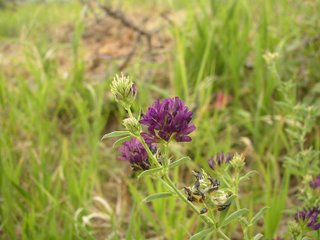 Alfalfa doesn't look like much from a distance, but up close the flowers are quite, quite pretty. This is my favorite color for it, but it also comes in paler purples and lavenders, some almost white. Let's see, it seems to be Medicago sativa, and can cause bloating in livestock if there's too much in the feed. [Plants of the RM]
Alfalfa doesn't look like much from a distance, but up close the flowers are quite, quite pretty. This is my favorite color for it, but it also comes in paler purples and lavenders, some almost white. Let's see, it seems to be Medicago sativa, and can cause bloating in livestock if there's too much in the feed. [Plants of the RM] Fireweed! Seems to be Alpine Fireweed, to be more specific. Epilobium latfolium. Oooh, it's edible! And can be eaten raw! [PRM] I'll only try it in an area where there's a lot of it, though.
Fireweed! Seems to be Alpine Fireweed, to be more specific. Epilobium latfolium. Oooh, it's edible! And can be eaten raw! [PRM] I'll only try it in an area where there's a lot of it, though.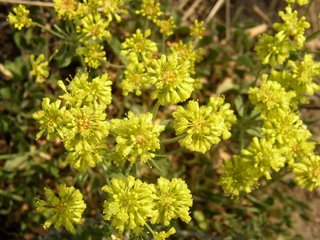
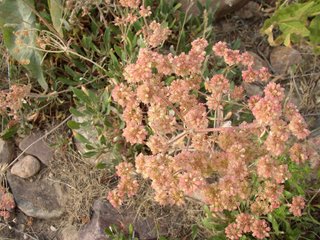 Two varieties of buckwheat. From what it says in PRM, there are a ton of different buckwheat species. Most common seems to be Sulphur buckwheat, Eriogonum umbellatum. I wonder how hard the seeds are to collect... Buckwheat is one of my staple foods.
Two varieties of buckwheat. From what it says in PRM, there are a ton of different buckwheat species. Most common seems to be Sulphur buckwheat, Eriogonum umbellatum. I wonder how hard the seeds are to collect... Buckwheat is one of my staple foods. I'm pretty sure this is Devil's Club, Oplopanax horridus. The leaves can get huge, like a foot or more across. I've got a picture of one with berries on it from Oregon. At any rate, its berries are NOT edible. The roots were sometimes mixed in with tobacco for smoking. The stems were sometimes used medicinally, but they're full of spines that have to be pulled off first [PRM].
I'm pretty sure this is Devil's Club, Oplopanax horridus. The leaves can get huge, like a foot or more across. I've got a picture of one with berries on it from Oregon. At any rate, its berries are NOT edible. The roots were sometimes mixed in with tobacco for smoking. The stems were sometimes used medicinally, but they're full of spines that have to be pulled off first [PRM].
Spider-Flower aka Bee-Plant aka Cleome serrulata. Much to my surprise, this is in the mustard family. It looks like a mint, and the leaves have a somewhat minty smell (though PRM claims that it has an "offensive" smell; *shrugs*). Anyway, this plant is mentioned in the Navajo songs along with corn, pumpkin and cotton, so it was important to them. And, yes, it's edible. Probably not. See the next post up. I'm reasonably certain this is called coneflower. Since it doesn't have any obvious petals, the only candidate I've got is Western rayless conflower, Rudbeckia occidentalis, but the leaves in the picture don't quite match these. The first time I saw these, I assumed they were buds that hadn't opened yet. A closer look revealed that the "buds" were in fact the flowers.
I'm reasonably certain this is called coneflower. Since it doesn't have any obvious petals, the only candidate I've got is Western rayless conflower, Rudbeckia occidentalis, but the leaves in the picture don't quite match these. The first time I saw these, I assumed they were buds that hadn't opened yet. A closer look revealed that the "buds" were in fact the flowers. White clover, Trifolium repens. This is the clover that grows in my dad's yard (he doesn't mind since it's a nitrogen-fixer). I ate a white cloverhead in Oregon, as I mentioned. Slightly sweet, but odd-tasting. Looks like the whole plant is edible, too. Oh, but don't eat red clover in the autumn. Edible & Medicinal Plants of the RM [EMPRM] says that red clover may contain toxic alkaloids in the fall.
White clover, Trifolium repens. This is the clover that grows in my dad's yard (he doesn't mind since it's a nitrogen-fixer). I ate a white cloverhead in Oregon, as I mentioned. Slightly sweet, but odd-tasting. Looks like the whole plant is edible, too. Oh, but don't eat red clover in the autumn. Edible & Medicinal Plants of the RM [EMPRM] says that red clover may contain toxic alkaloids in the fall.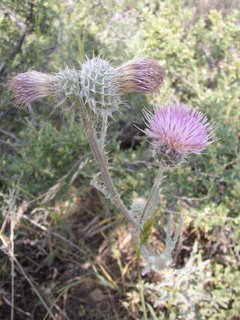 I'm not completely certain, but I think this is bull thistle, Cirsium vulgare. My books all have pinker pictures, but it's the closest match. If it's not bull thistle, it's a close relative.
I'm not completely certain, but I think this is bull thistle, Cirsium vulgare. My books all have pinker pictures, but it's the closest match. If it's not bull thistle, it's a close relative.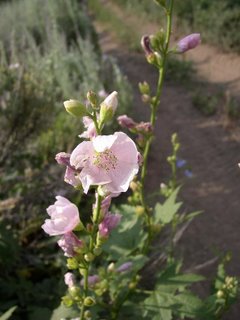 Mountain Hollyhock, Iliamna rivularis. I also saw these, or something very similar, growing along the road around Scappoose. Pam didn't think they were hollyhocks. I was reasonably sure that they were, and more certain now, though there's something called checkermallow that has a similar appearance.
Mountain Hollyhock, Iliamna rivularis. I also saw these, or something very similar, growing along the road around Scappoose. Pam didn't think they were hollyhocks. I was reasonably sure that they were, and more certain now, though there's something called checkermallow that has a similar appearance. I don't remember seeing these before, but they are gorgeous. Subalpine Fleabane, Erigeron peregrinus. {UPDATE: There seem to be several purple asters that have rounded petals. I still think Subalpine is the best match, though it's not even listed at the link.}
I don't remember seeing these before, but they are gorgeous. Subalpine Fleabane, Erigeron peregrinus. {UPDATE: There seem to be several purple asters that have rounded petals. I still think Subalpine is the best match, though it's not even listed at the link.} I'm posting this one mainly for the butterflies, but the plant matches the description for Grey Horsebrush, Tetradymia canescens. No picture with the description, so I'm not completely certain.
I'm posting this one mainly for the butterflies, but the plant matches the description for Grey Horsebrush, Tetradymia canescens. No picture with the description, so I'm not completely certain.




1 comment:
Definitely not devil's club up there! Devil's club flowers are on a tall spike, are pale green, and tinier than that. What you have is probably thimbleberry, similar to raspberries but with bigger, broader leaves like in that picture.
Post a Comment